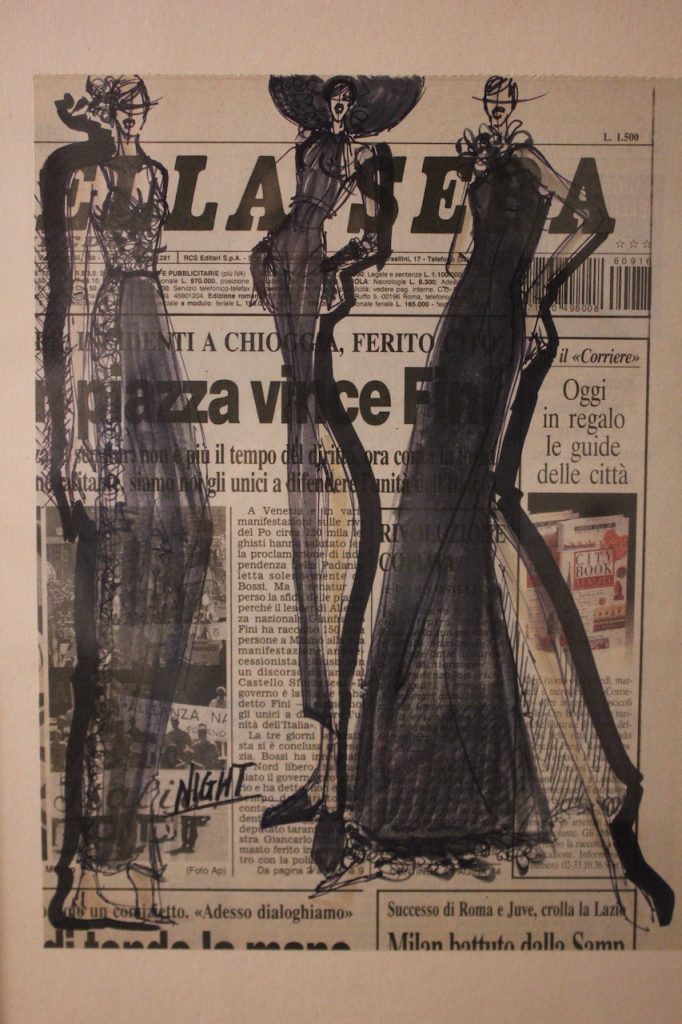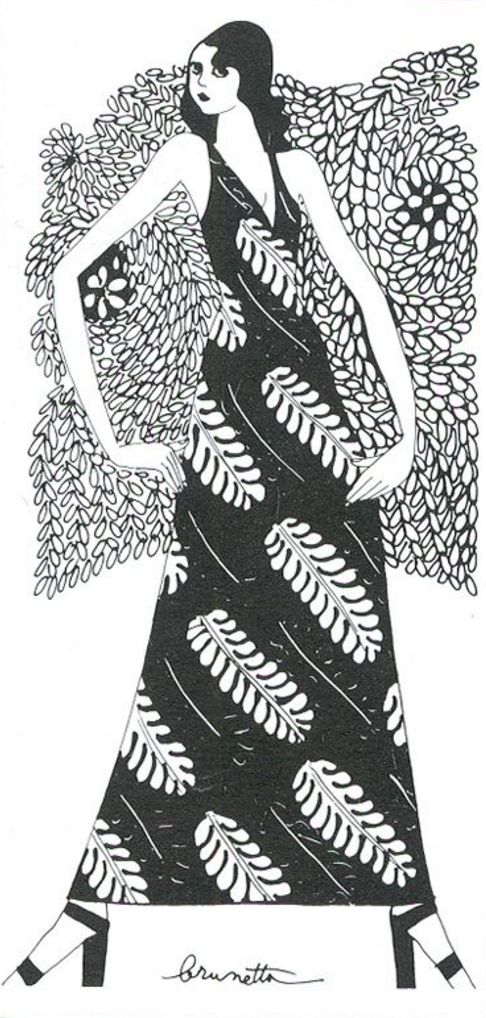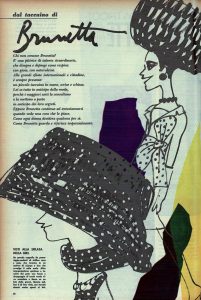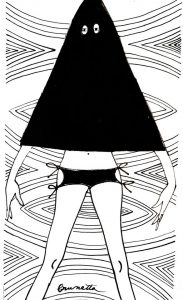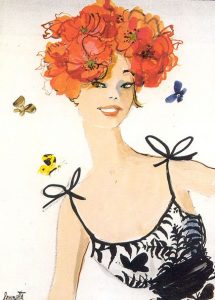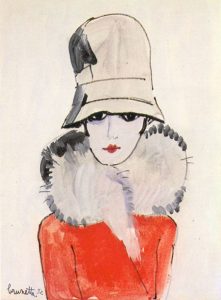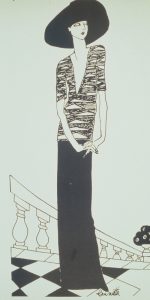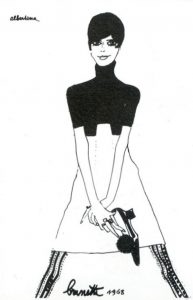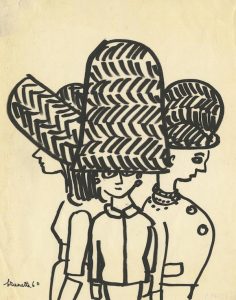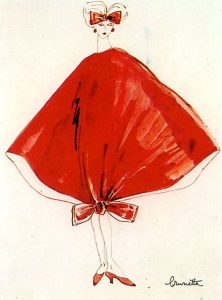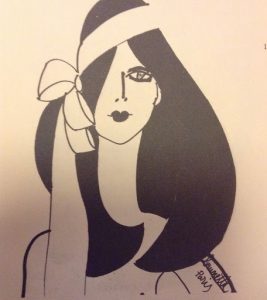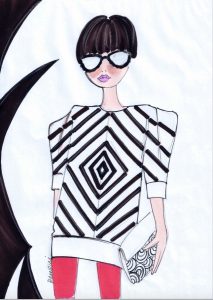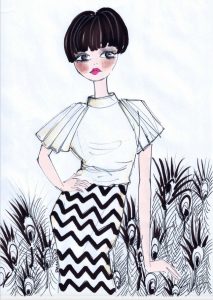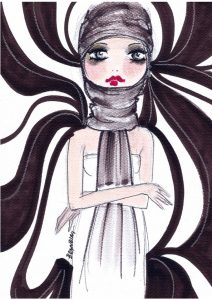Travel sketches on the Courier by Beatrice Brandini, 1999
“The evening in a printed dress” Brunetta
Brunetta Mateldi Moretti was one of the greatest illustrators of the twentieth century. Her style was quick and ironic, always extraordinarily light.
“From Brunetta’s notebook”, on Amica
I speak of her with a great deal of admiration (belatedly compared to many personalities I have treated in recent years), but I believe that her figure, especially after her death in 1989, has not been recognized as much as she would have deserved. I remember, very young, having loved her sketches and having cut them from the pages of my father’s Corriere. I still keep them as pure gold.
“Burka” Brunetta
If we ask young fashion students who Brunetta is (as for Antonio Lopez, René Gruau, Walter Albini…) I think that few of them can answer correctly, and this is a great pity.
Untitled, 1960 Brunetta
Her friend and colleague Camilla Cederna (1911 – 1997) remembered her thus: “with that dry and ironic sign of hers, the precision in grasping the ridiculous side of fashion, even if it is signed by the greats”. At Brunetta, I said, I also recognized her almost media capacity: I described the play-boy of the moment, and here she portrays him as he is without ever having seen him … the faces are always right, there were those who took offense because he recognized himself in the drawing. In short, a special artist: I have always thought that if she had not worked in Italy, but in Paris or New York, Brunetta would have been a big star in her branch, always in the best magazines, and overpaid, which we (also given the her innate modesty) has never happened to her “.
Untitled, 1943 Brunetta
She completed artistic studies at the Academy of Fine Arts in Bologna and then in Turin, we are in the 1920s, to arrive in Milan where her encounter with Filiberto Mateldi, a futurist painter and illustrator, will change her life.
Untitled, Brunetta
The two artists married in 1930, starting to collaborate together on editorial illustration. But Brunetta is not a simple designer, in fact in her long and fruitful career she was an illustrator, poster designer, painter and journalist.
She made her debut with Domenica del Corriere, in 1924, but throughout her career she collaborated with Corriere della Sera, with Lidel, with Il Dramma, la Lettura, La Donna, Amica, Grazia, Herper’s Bazaar, Vogue and many others.
Untitled, 1968 Brunetta
She was loved by the great artists of the time, admired by gods such as Coco Chanel, Dior, Balenciaga, Jeanne Lanvin, Pierre Balmain; Diana Vreeland, the famous director of Harper’s Bazaar and Vogue, invites her to New York.
Perhaps the fact that she dedicated her hilarious sketches especially to fashion didn’t help her, at that time, it wasn’t recognized as an artistic expression, although figures like Vionnet, Dior, Balenciaga … had already honored us with masterpieces ; fashion was something frivolous, for a rich and bored elite. Moreover, Italy has always suffered from an inferiority complex, especially towards its cousins from beyond the Alps. Add to that having been an (independent) woman, I think it must not have been easy at all for the great Brunetta to move in those years.
Sketch for la Rinascente, 1960 Brunetta
Brunetta loved women because already in the Thirties she portrayed them in a modern, emancipated way. They were expressive women, with those deep black eyes, never smiling, with a strong personality.
“My hands, my mind have never been inactive. I have read, studied, watched, listened a lot. I am made of poetry and patience. “
Sensational on the platform at Pitti Florence, 1958. Brunetta
In 1957, and until 1976, with Camilla Cederna she signed one of the most famous columns of the twentieth century in Espresso “The weak side”, an ironic and disenchanted portrait of the city of success, Milan. In that column two unforgettable women described fashions and ways, vices and tics, habits and customs of the moment. Camilla wrote and Brunetta illustrated with a sketch, the combination between the two intellectuals was perfect, an artistic-cultural symbiosis, with ironic, irresistible features.
Untitled, Brunette
Brunetta has exhibited in galleries and museums, received prizes and awards, but after her death she was forgotten. An injustice and above all a great loss for those who did not live in those years and never had the privilege of knowing she.
Brunetta’s mood by Beatrice Brandini
“How do you learn to draw? As a child you learn immediately, it is as if the child has a consciousness of wanting to recognize things. Then it passes, it is one of the many curiosities, but there is the child who goes further and allows himself to be implemented by the most sensational forms: by the beauty of all the things that then come together to end in a unique passion “. Brunetta in Brunetta fashion criticism history, University of Parma, Center for studies and archive of communication 1981
Drawing means having the courage to try your hand at one of the most difficult things that exist, yes, because you never learn to draw: you draw for life is like a marriage … “ Brunetta in Brunetta fashion criticism history, University of Parma, Centro communications studies and archive 1981
“Brunetta” by Beatrice Brandini
Good life to everyone!
Beatrice


